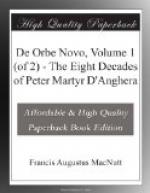[Note 3: Peter Martyr was not ignorant of the jibes his Latin evoked amongst the purists in Rome. The cultivated tympanum of Cardinal Bembo and other Ciceronians at the Pontifical Court received painful shocks from certain corrupt expressions in his decades. His repeated explanations of his deflections from classical nomenclature are, however, reasonable.]
[Note 4: Meaning, of course, in the duchy, not the city. The passage reads: Neutro cruciare statuo ad summum; voloque sciant, me insubrem esse non Latium; et longe a Latio natum, quia Mediolani; et longissime vitam egisse, quia in Hispania.]
Vincent Yanez discovered that the chieftains were elected for only one year. Their followers obeyed them in making war or in signing peace. Their villages are built around this immense gulf. Five of these caciques offered gifts to the Spaniards, and I have wished to record their names in memory of their hospitality: Chiaconus Chianaocho, Chiaconus Fintiguanos, Chiaconus Chamailaba, Chiaconus Polomus, Chiaconus Pot.
This gulf is called Bahia de la Natividad, because Columbus discovered it on the Feast of Christmas; but he only sailed by, without penetrating into the interior. The Spaniards simply call it Bahia. Having established friendship with these chieftains, Vincent Yanez continued his voyage[5] and found to the east countries which had been abandoned because of frequent inundations, and a vast extent of marsh lands. He persisted in his undertaking until he reached the extreme point of the continent[6]; if indeed we may call points, those corners or promontories which terminate a coast. This one seems to reach out towards the Atlas, and therefore opposite that part of Africa called by the Portuguese the Cape of Good Hope, a promontory in the ocean formed by the prolongation of the Atlas Mountains. The Cape of Good Hope, however, is situated within thirty-four degrees of the antarctic pole, whereas this point in the New World lies within the seventh degree. I think it must be part of that continent which cosmographers have named the Great Atlantis, but without giving further details as to its situation or character.
[Note 5: Comparing this account of Pinzon’s voyage with that of Vespucci, it is seen that Peter Martyr describes the itinerary reversed, making Pinzon finish where Vespucci makes him begin.]
[Note 6: Cape Sant Augustin.]
And since we have now reached the shores of the first land encountered beyond the Pillars of Hercules, perhaps it may not be out of place to say something of the motives which might have provoked war between the Catholic King, Ferdinand of Spain, and Emanuel of Portugal, had they not been father-in-law and son-in-law. Note that I say Portugal and not Lusitania, contrary to the opinion of many persons who certainly are not ignorant, but are not less certainly, sadly mistaken. For if it be Lusitania which eminent geographers locate between the Douro and the Guadiana, in what part of Lusitania does Portugal lie?




